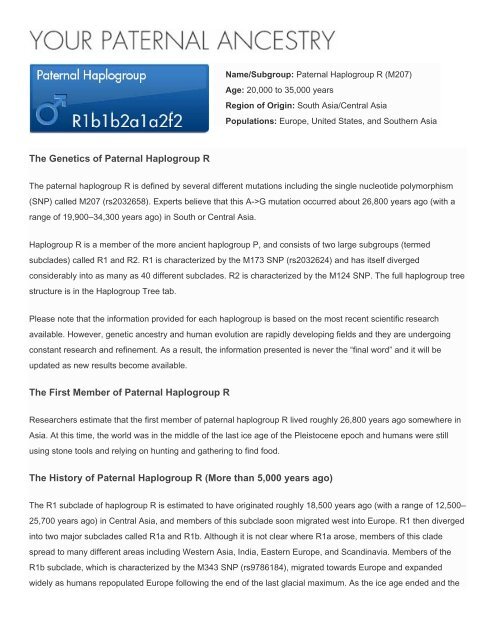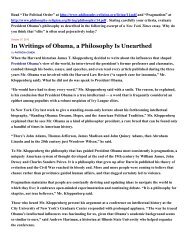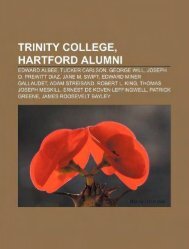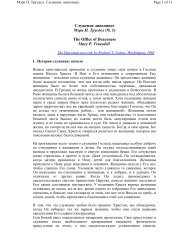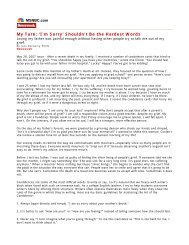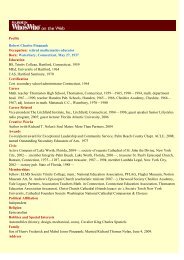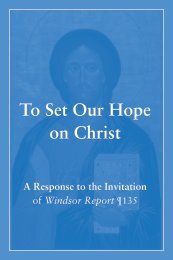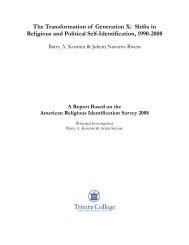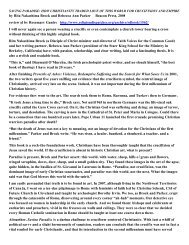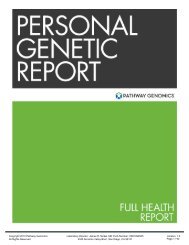Ancestry Report (Paternal) - Genetic Report - Philosophy and Religion
Ancestry Report (Paternal) - Genetic Report - Philosophy and Religion
Ancestry Report (Paternal) - Genetic Report - Philosophy and Religion
You also want an ePaper? Increase the reach of your titles
YUMPU automatically turns print PDFs into web optimized ePapers that Google loves.
Name/Subgroup: <strong>Paternal</strong> Haplogroup R (M207)Age: 20,000 to 35,000 yearsRegion of Origin: South Asia/Central AsiaPopulations: Europe, United States, <strong>and</strong> Southern AsiaThe <strong>Genetic</strong>s of <strong>Paternal</strong> Haplogroup RThe paternal haplogroup R is defined by several different mutations including the single nucleotide polymorphism(SNP) called M207 (rs2032658). Experts believe that this A->G mutation occurred about 26,800 years ago (with arange of 19,900–34,300 years ago) in South or Central Asia.Haplogroup R is a member of the more ancient haplogroup P, <strong>and</strong> consists of two large subgroups (termedsubclades) called R1 <strong>and</strong> R2. R1 is characterized by the M173 SNP (rs2032624) <strong>and</strong> has itself divergedconsiderably into as many as 40 different subclades. R2 is characterized by the M124 SNP. The full haplogroup treestructure is in the Haplogroup Tree tab.Please note that the information provided for each haplogroup is based on the most recent scientific researchavailable. However, genetic ancestry <strong>and</strong> human evolution are rapidly developing fields <strong>and</strong> they are undergoingconstant research <strong>and</strong> refinement. As a result, the information presented is never the “final word” <strong>and</strong> it will beupdated as new results become available.The First Member of <strong>Paternal</strong> Haplogroup RResearchers estimate that the first member of paternal haplogroup R lived roughly 26,800 years ago somewhere inAsia. At this time, the world was in the middle of the last ice age of the Pleistocene epoch <strong>and</strong> humans were stillusing stone tools <strong>and</strong> relying on hunting <strong>and</strong> gathering to find food.The History of <strong>Paternal</strong> Haplogroup R (More than 5,000 years ago)The R1 subclade of haplogroup R is estimated to have originated roughly 18,500 years ago (with a range of 12,500–25,700 years ago) in Central Asia, <strong>and</strong> members of this subclade soon migrated west into Europe. R1 then divergedinto two major subclades called R1a <strong>and</strong> R1b. Although it is not clear where R1a arose, members of this cladespread to many different areas including Western Asia, India, Eastern Europe, <strong>and</strong> Sc<strong>and</strong>inavia. Members of theR1b subclade, which is characterized by the M343 SNP (rs9786184), migrated towards Europe <strong>and</strong> exp<strong>and</strong>edwidely as humans repopulated Europe following the end of the last glacial maximum. As the ice age ended <strong>and</strong> the
earth began to warm, members of R1b exp<strong>and</strong>ed as far south as Italy, as far west as Spain, <strong>and</strong> as far north asGreat Britain, which, at the time, was connected to continental Europe due to very low global sea levels.The R2 subclade is estimated to have branched off of haplogroup R in South Asia just a few thous<strong>and</strong> years afterhaplogroup R originated. Members of R2 migrated into India <strong>and</strong> Pakistan as part of the second major migration ofhumans into the Indian subcontinent. Members of the R2 subclade are also found in Central Asia <strong>and</strong> the Caucasus.<strong>Paternal</strong> Haplogroup R in the Modern World (5,000 years ago-Present)<strong>Paternal</strong> haplogroup R developed an enduring presence in Europe (particularly in the western region of thecontinent), <strong>and</strong> that presence remains strong even today. Members of haplogroup R would have been involved inmany of the advancements in culture <strong>and</strong> technology that took place in Europe since the end of the last ice age.Such events include the building of Stonehenge (5,000 years ago), the rise of the Bronze Age (4,500 to 3,000 yearsago) <strong>and</strong> the founding of the city of Rome (over 2,500 years ago).Several famous people belong to haplogroup R. Members of subclade R1a, for example, include the descendants ofthe Celtic hero Somerled, who is credited with ousting the Vikings from western Scotl<strong>and</strong> in the 12th century.Ironically, since many of the Vikings who established settlements in Scotl<strong>and</strong>, Irel<strong>and</strong>, <strong>and</strong> Engl<strong>and</strong> during the 9th,10th, <strong>and</strong> early 11th centuries were also members of subclades R1a <strong>and</strong> R1b, Somerled may have been descendedfrom the Vikings he drove out of Scotl<strong>and</strong>. Journalist <strong>and</strong> CNN anchor Anderson Cooper is also a member of theR1a subclade.There are also several famous members of the R1b subclade, including at least 8 Presidents of the United States,based on Y-DNA testing of either descendants or paternal relatives:ooooooooJohn Adams (2nd)John Quincy Adams (6th)Zachary Taylor (12th)Franklin Pierce (14th)James Buchanan (15th)Abraham Lincoln (16th)William McKinley (25th)Woodrow Wilson (28th)Other famous members of the R1b subclade include the 4th century Irish king Niall of the Nine Hostages (alsoknown as Niall Noígíallach), the last Russian Tsar Nicholas Romanov II (1868 – 1918), director of the NationalGenographic Project Spencer Wells, <strong>and</strong> Chris Haley (paternal nephew of author Alex Haley).<strong>Paternal</strong> Haplogroup R Today
Today, paternal haplogroup R is one of the most common haplogroups in the world. In some parts of Engl<strong>and</strong>,Irel<strong>and</strong>, Scotl<strong>and</strong>, Spain, <strong>and</strong> France, for example, the frequency of haplogroup R is greater than 90% of the malepopulation. In the United States, where much of the population is of European ancestry, the frequency of haplogroupR is potentially over 40%.The frequency of the R1b subclade is highest in Western Europe <strong>and</strong> declines steadily in a gradient from WesternEurope into Eastern Europe <strong>and</strong> Asia. R1b is also found in small percentages in North Africa. The R1a subclade ismost common in Eastern Europe but can also be found at lower frequencies in Southeast Asia <strong>and</strong> Australia.Outside of Europe <strong>and</strong> the United States, most of the members of haplogroup R are part of sub-haplogroup R2.Frequencies of sub-haplogroup R2 are highest in East India <strong>and</strong> Sri Lanka. Sub-haplogroup R2 can also be found inTurkey <strong>and</strong> Pakistan.SourcesAdams Surname Y-DNA Results, Presidential Adams Family. Retrieved August 9, 2009 from:http://freepages.genealogy.rootsweb.ancestry.com/~jswdna/adamsresults.htmlAnderson Cooper 360°, Transcript of February 22, 2006. Retrieved August 9, 2009 from CNN:http://transcripts.cnn.com/TRANSCRIPTS/0602/22/acd.01.htmlCold Spring Harbor Laboratory Press (2008). Y-Chromosome Phylogenetic Tree. Retrieved January 19, 2009, fromthe Family Tree DNA Web site: http://www.familytreedna.com/pdf-docs/2008-Y-Chromosome-Phylogenetic-Tree.pdfEdward, J. (2008). Overview: The Vikings, 800 to 1066. Retrieved January 19, 2009, from the BBC Web site:http://www.bbc.co.uk/history/ancient/vikings/overview_vikings_01.shtmlEupedia (2008). Origins, Age, Spread <strong>and</strong> Ethnic Association of European Haplogroups <strong>and</strong> Subclades. RetrievedJanuary 19, 2009, from the Eupedia Web site: http://www.eupedia.com/europe/origins_haplogroups_europe.shtmlEvgeny I. Rogaev et al., Genomic Identification in the Historical Case of the Nicholas II Royal Family, PNAS,31;106(13):5258-63, March 2009.Ian Johnston, DNA Shows Celtic Hero Somerled's Viking Roots, The Scotsman, 26 April 2006.International Society of <strong>Genetic</strong> Genealogy, Famous DNA, Retrieved August 9, 2009 from the ISOGG website:http://www.isogg.org/famousdna.htmInternational Society of <strong>Genetic</strong> Genealogy, Famous Haplogroups, Retrieved August 9, 2009 from the ISOGGwebsite: http://www.isogg.org/famoushg.htm
International Society of <strong>Genetic</strong> Genealogy, Presidential DNA, Retrieved August 9, 2009 from the ISOGG website:http://www.isogg.org/presdna.htmLaoise T. Moore, Brian McEvoy, Eleanor Cape, Katharine Simms, <strong>and</strong> Daniel G. Bradley, A Y-ChromosomeSignature of Hegemony in Gaelic Irel<strong>and</strong>, The American Journal of Human <strong>Genetic</strong>s, 78(2): 334–338, February2006.National Geographic Society (2008). Atlas of Human Journey: <strong>Genetic</strong> Markers. Retrieved January 19, 2009, fromthe Genographic Project Web site: https://genographic.nationalgeographic.com/genographic/lan/en/atlas.htmlPryor, F. (2006). Overview: From Neolithic to Bronze Age, 8000 – 80 BC. Retrieved January 19, 2009, from the BBCWeb site: http://www.bbc.co.uk/history/ancient/british_prehistory/overview_british_prehistory_04.shtmlR. Spencer Wells, et al., The Eurasian Heartl<strong>and</strong>: A Continental Perspective on Y-Chromosome Diversity, PNAS,98:10244-10249, August 28, 2001.Tatiana M. Karafet, et al., New Binary Polymorphisms Reshape <strong>and</strong> Increase Resolution of the Human YChromosomal Haplogroup Tree, Genome Research, April 2, 2008.
The migration map shows approximately when yourancestor originated <strong>and</strong> where they migrated across theglobe. You can move the pointer along the bottom of themap to see different timeframes, or click on other migrationlines to see the patterns of different haplogroups.
Al Roker - YDNA EAl Roker is a weather <strong>and</strong> news broadcaster for the Today Show, who reports on breaking storiesworldwide. As a television <strong>and</strong> radio personality, Roker is best known for his weather reports. Thoughhe originally wanted to be a cartoonist, Roker has risen to be one of the most well known voices <strong>and</strong>faces in the media.He was born in Queens, N.Y. <strong>and</strong> attended high school in Manhattan. He was very involved in his high school’scartoonist club. Later he attended State University of New York at Oswego where he majored in bothjournalism/broadcasting <strong>and</strong> graphic design. After college he was hired to be a weather forecaster at a local newsstation in New York. In 1995 Roker became the host of both The Al Roker Show <strong>and</strong> a popular game show onMSNBC.oooOne of his most memorable appearances was a reporting episode from inside a hurricane where he wasforced to hold onto his cameraman for stability.He had Gastric bypass surgery in 2002, in accordance with his father’s wishes, to lose weight.He is a cousin of the late actress Roxie Roker <strong>and</strong> her son, rock star, Lenny Kravitz.Al Roker currently is working as a co-host on Wake Up with Al! on The Weather Channel. Roker is the mostrecognizable weather anchor because of his diverse television history. Al Roker continues to be involved in severaldifferent projects of differing fields including being a guest voice on Disney Channel’s The Proud Family.
Read more about Al Roker.Alex<strong>and</strong>er Hamilton - Y-DNA, Haplogroup IAlex<strong>and</strong>er Hamilton was America’s first United States Secretary of Treasury <strong>and</strong> one of our foundingFathers was born on January 11, 1755 or 1757. Hamilton helped bring a voice to a young America byco-writing the Federalist Papers (he wrote 51 of the 85 essays). His belief in domestic fiscal goals<strong>and</strong> strong foreign policy were the bearing for the creation of the Federalist Party. Hamilton accomplished manyamazing feats in his lifetime.o Hamilton was the only New Yorker to sign the Constitution.o He founded The New York Post in 1801 <strong>and</strong> the Bank of New York in 1784.o Thomas Jefferson’s Vice President, Aaron Burr, shot <strong>and</strong> killed Hamilton in a duel.His pro-federal interpretations of the U.S. Constitution are another legacy. It was through scrutinizing what waswritten in the Constitution that he was able to establish America’s first national bank, the United States Mint in 1792.He has appeared on multiple notes of American currency including the $2, $5, $10 <strong>and</strong> $50 bill. Today he isfamously known as the face of the $10 bill. He also appears on the $500 Series EE Savings Bond.Read more about Alex<strong>and</strong>er Hamilton.Czar Nicholas II - YDNA R1bCzar Nicholas II was the last <strong>and</strong> arguably least successful, emperor of Russia. His official title wasEmperor <strong>and</strong> Autocrat of all the Russias but also held the titles of Gr<strong>and</strong> Duke of Finl<strong>and</strong>, lastEmperor of Russia, <strong>and</strong> King of Pol<strong>and</strong>.His rule began when he succeeded his father, Czar Alex<strong>and</strong>er III, in 1894 though he had very little experience ingovernment. Later, in the same year, he married Princess Alex<strong>and</strong>ra of Hesse-Darmstadt (a duchy in Germany) <strong>and</strong>had five children. They had four daughters <strong>and</strong> one son, who suffered from the disease hemophilia. Nicholas II wasvery untrusting of his ministers but was incapable of carrying out the task of ruling the large Russian empire alone,so he often looked to Alex<strong>and</strong>ra who encouraged his autocratic tendencies.oooNicholas is currently regarded as Saint Nicholas the Passion-Bearer by the Moscow Patriarchates of theRussian Orthodox Church.Critics nicknamed him ‘Nicholas the Bloody.’He witnessed his gr<strong>and</strong>father’s assassination.
In early 1917 Nicholas lost the support of the army <strong>and</strong> had no choice but to abdicate his position <strong>and</strong> flee with hisfamily. Nicholas moved his family to various locations but were eventually imprisoned <strong>and</strong> executed. Czar NicholasII rule saw Imperial Russia go from being one of the great powers in the world to an economic <strong>and</strong> military disaster.Read more about Czar Nicholas II.Franklin Pierce - YDNA R1bFranklin Pierce is most famous for his time as the 14th president of the United States from 1853 to1857. The election of 1852 was certainly a memorable one. With a slogan, "We Polked you in 1844;we shall Pierce you in 1852!" they took the election. It was the last time that the Whigs (a politicalparty at the time) had a c<strong>and</strong>idate for election. Once he was elected, Pierce broke several records. At the time, hewas the youngest president to take office. He was also the first president to recite his inaugural address frommemory.oooAt the time, he was the youngest president to take office.He was the first president to recite his inaugural address from memory.Pierce was ranked among the least effective presidents.Pierce was not suspected to be a c<strong>and</strong>idate because his political service was sparse before the nomination. He hadserved in the Mexican-American War <strong>and</strong> quickly became colonel. Pierce identified himself in the Democratic Party.He worked in several of the lower houses <strong>and</strong> was later elected to congress. Pierce had a challenging family life asall three of his children died at a young age.During his presidency, there were no states admitted into the union, which was odd at this time. The U.S. wasgrowing very rapidly <strong>and</strong> added states often during this period in history.Read more about Franklin Pierce.Genghis Kahn - YDNA CGenghis Kahn, whose real name was Temüjin, was a 13th century Mongolian ruler who founded theMongol empire which included parts of China, Central Asia, the Middle East <strong>and</strong> Europe. As a childhe had to endure a life of violence <strong>and</strong> enslavement, which helped prepare him to become a verypowerful tribal chieftain. As a tribal chieftain he was able to unite rival clans that lead to the creation of the MongolEmpire <strong>and</strong> his title Genghis Kahn, meaning supreme “ruler” or “Emperor.”
oooSome modern historians believe that toward the end of his life he tried to establish legal equality of allindividuals, including women.Kahn had complete trust in his generals <strong>and</strong> often gave them the same privileges reserved only for family.He is credited for the introduction of the first written Mongolian laws.In the three following decades he led a constant military campaign that ravaged vast areas <strong>and</strong> conquered millionsof people, which lead to his current place in history as a brutal <strong>and</strong> violent conqueror. Quick cavalry attacks <strong>and</strong> veryinventive methods of siege warfare were some of his more successful military tactics <strong>and</strong> he is well known forsuccessfully adapting his methods to meet new challenges.Over the years his image as a warmonger in western civilizations has been reassessed. With the acknowledgmentthat under his rule there was a beneficial transfer of culture <strong>and</strong> technology as his armies moved through Asia, theMiddle East <strong>and</strong> Europe, Khan was more than just a bloodthirsty tyrant <strong>and</strong> conqueror. He united the Mongols <strong>and</strong>established one of the most culturally <strong>and</strong> ethnically diverse empires of its time that lasted more than 150 years afterhis death.Read more about Genghis Khan.Joseph Stalin - YDNA GJoseph Stalin was the General Secretary of the Communist Party of the Soviet Union’s CentralCommittee (1922-1953). Following the death of Vladimir Lenin, the first Soviet Union Head of State,Stalin became leader of the Soviet Union. He was responsible for launching a comm<strong>and</strong> economy,replacing the New Economic Policy with the Five-Years Plan <strong>and</strong> creating a period of rapid industrialization <strong>and</strong>economic collectivization.oooStalin formed the “Iron Curtain” of Soviet Rule leading to the Cold War.Under Stalin the scope <strong>and</strong> power of the state’s secret police <strong>and</strong> intelligence agencies were greatlyincreased.In an attempt to improve his public image he made himself the focus of Soviet art <strong>and</strong> literature <strong>and</strong> wascredited with almost god-like qualities.Stalin launched the Great Purge in the late 1930s, which was a campaign to purge people accused of sabotage,terrorism, or treachery from the Communist Party <strong>and</strong> it later extended to the military. The suspects were usuallyexecuted, imprisoned in labor camps, or exiled after being captured. Millions of ethnic minorities were laterdeported.
Stalin led the Soviet Union to sign a non-aggression pact with Nazi Germany in 1939, which was followed by aSoviet invasion of Pol<strong>and</strong>, Finl<strong>and</strong>, the Baltics, Bessarabia <strong>and</strong> northern Bukovina. Two years later the Germansviolated the pact <strong>and</strong> the Soviet Union joined the Allies in World War II, which lead to them playing a large role indefeating the Axis. The Soviet Union had the largest death toll of any other country in the war.Read more about Joseph Stalin.Thomas Jefferson - Y-DNA, Haplogroup TThomas Jefferson, born April 13, 1743 in Virginia, was America’s third president. He is considered,along with George Washington, to be one of the United States most influential Founding Fathers. Hewas highly intelligent <strong>and</strong> graduated from the College of William <strong>and</strong> Mary in Williamsburg at 19. Atthe age of 27, he went on to study law with George Wythe. He dabbled <strong>and</strong> excelled in Latin, Greek, French,philosophy, mathematics, metaphysics <strong>and</strong> the violin.He married Martha Wayles Skelton in 1772, at the age of 29, <strong>and</strong> they had six children together. Through DNAtesting, it has been proven that Jefferson also fathered six children through Sally Hemings, with whom he carried afour-decade-long affair. He freed all the children <strong>and</strong> they left his home, The Monticello, as free persons.oooHe was the primary author of the Declaration of Independence.He was instigator of the Louisiana Purchase <strong>and</strong> the Lois <strong>and</strong> Clark Expedition.Jefferson was also one of the founders of the Democratic-Republican Party.After acting duties of being Washington’s first United States Secretary of State from 1790-1793 <strong>and</strong> later, JohnAdams’ Vice President from 1797-1801, Jefferson became Americas’ third President in 1801. He remained in officefor eight years until 1809.It was during his run as President that he repealed the Judiciary Act of 1801, won the First Barbary War (1801-1805), founded in 1802 the U.S. Military Academy at West Point, doubled the size of the United States by signingThe Louisiana Purchase <strong>and</strong>, in March 1807, signed a bill making the importation of slaves illegal.Read more about Thomas Jefferson.William Harvey - YDNA E1b1b1William Harvey was an English physician who was born April 1, 1578 <strong>and</strong> died June 3, 1657. Harveyattended the Gonville <strong>and</strong> Caius College in Cambridge where he received a Bachelor of Arts degreein 1597. Later he attended the University of Padua in Italy. He later married a daughter of a well-
known London physician <strong>and</strong> worked at St. Bartholomew’s Hospital from 1609-43.oooHe is most famous for his work with the human heart <strong>and</strong> circulation system.He was the first to correctly describe, in exact detail, the systemic circulation <strong>and</strong> properties of bloodpumped by the heart.He was included on the list of “the ten most influential people of the second millennium” in the WorldAlmanac <strong>and</strong> Book of Facts.Despite the fact pulmonary circulation had already been described in the sixteenth century, Harvey is credited forthe best description of the human circulation system. Harvey’s rediscovery <strong>and</strong> redefining of pulmonary circulationplaced blood throughout the whole body <strong>and</strong> not just in the lungs, which was the common belief at that time.Harvey described blood flow as continuous <strong>and</strong> recognized two different types of blood based on color. The darkerred blood, he described as venous <strong>and</strong> brighter thinner blood as arterial, each separate in function. Harvey was thefirst to show that both of these kinds of blood came from the heart, rather than different locations.Harvey estimated the heart expelled about 1/6 of an ounce every time it pumped. He then estimated the productionof blood by calculating about 1000 beats per half hour <strong>and</strong> multiplying by 48 to get around 540 pounds of blood eachday. He showed two separate circulatory systems, one for the lungs <strong>and</strong> one for the heart. Harvey was truly ascientific pioneer of his time.Read more about William Harvey.Niall of the Nine Hostages - YDNA R1bNiall of the Nine Hostages was an Irish King <strong>and</strong> supposed ancestor of the Ui Neill kindred whodominated Irel<strong>and</strong> from the 6th century through the 10th century. He is placed on the traditional list ofHigh Kings of Irel<strong>and</strong> <strong>and</strong> his reign spanned from the late 4th century to the early 5th century.oooThe title Niall of the Nine Hostages is said to come from him receiving five hostages from the five Irishprovinces <strong>and</strong> four others from Scotl<strong>and</strong>, the Saxons, the Britons <strong>and</strong> the Franks.Niall is believed to have been killed in battle by the son of the king of Leinster.Through genetic testing it is believed that there are roughly 2-3 million males alive today who havedescended from him.Much of the history on Niall’s life is mixed with legend making it difficult to know the factual story of his rise to thethrone. The most well known story is that Niall’s father Eochaid had five sons, four with his first wife <strong>and</strong> one, Niall,with his second. When his first wife saw Niall’s popularity among the nobles, she dem<strong>and</strong>ed that Eochaid name asuccessor.
Eochaid decided to leave it to a competition. His five sons were sent out hunting <strong>and</strong> they each went looking forwater. They all came upon a well, guarded by a grotesque hag who said she would only give them water for a kiss.Niall is the only one to give her a kiss <strong>and</strong> she ends up being a beautiful maiden, the Sovereignty of Irel<strong>and</strong>. Shegranted him water <strong>and</strong> the kingship for many generations.Read more about Niall of the Nine Hostages.Nikita Trubetskoy - YDNA R1aNikita Trubetskoy was a Russian Field Marshall, statesman <strong>and</strong> minister of defense of Russia in1760.oooTrubetskoy is known to have been a connoisseur of art <strong>and</strong> a very enlightened man.He was appointed General-Prosecutor of the Senate.When he died he was Marechal of Russia, senator <strong>and</strong> actual private counselor.Peter I gave Trubetskoy his start to his military career by having him be his batman. He then went on to join thePreobrazhensky Regiment in 1722 at the rank of Sergeant <strong>and</strong> was promoted in the same year to ensign. Hebecame a staunch opponent of the Supreme Privacy Council <strong>and</strong> gave his support to the empress Anna Ivanovna.He took part in all the Russian wars up until 1740 when he presided as the minister of the army.Trubetskoy later went on to become a senator <strong>and</strong> the president of the Military Board.Read more about Nikita Trubetskoy.The Wright Brothers - YDNA E1b1b1Wright Brothers are most famous for their invention <strong>and</strong> testing of the first successful aircrafts. TheWright Brothers are credited with the invention of the first flying aircraft that held humans. Mostinnovative was their invention of the “three-axis control,” which allows a pilot to steer an aircraftthrough pitch, roll <strong>and</strong> yaw. This method is still the st<strong>and</strong>ard for all fixed wing aircrafts today.The Wright Brothers, Orville <strong>and</strong> Wilbur, were born in Dayton, Ohio. From there the Wright Brothers moved to NorthCarolina where they flew their first aircraft. They had little formal education <strong>and</strong> developed many of their ideastogether. They tried to formulate hypotheses based on the flying patterns of birds. This is when they came up withthe idea of gliding. Later their aircraft inventions would become known as gliders.oTheir three-axis control method became st<strong>and</strong>ard <strong>and</strong> remains st<strong>and</strong>ard on all kinds of fixed-wing aircraft.
ooThey gained the majority of their mechanical skills through years of working on printing presses, bicycles,motors <strong>and</strong> other machinery.The Wright Brothers <strong>and</strong> their invention is a figurehead for both North Carolina <strong>and</strong> Ohio.The Wright brothers worked in printing presses, bicycle shops <strong>and</strong> did other mechanical work which helped indeveloping the aircraft. They started building <strong>and</strong> working on glider airplanes in 1900. Differing from other opinionsat the time, the Wright Brothers felt that a stable winged aircraft would work best. Their first successful flight of apowered aircraft carrying Wilbur, after he’d won a coin toss, was on December 13, 1903. The Wright Brothers todayrepresent the American dream. They characterize the age of invention.Read more about Wright Brothers.


